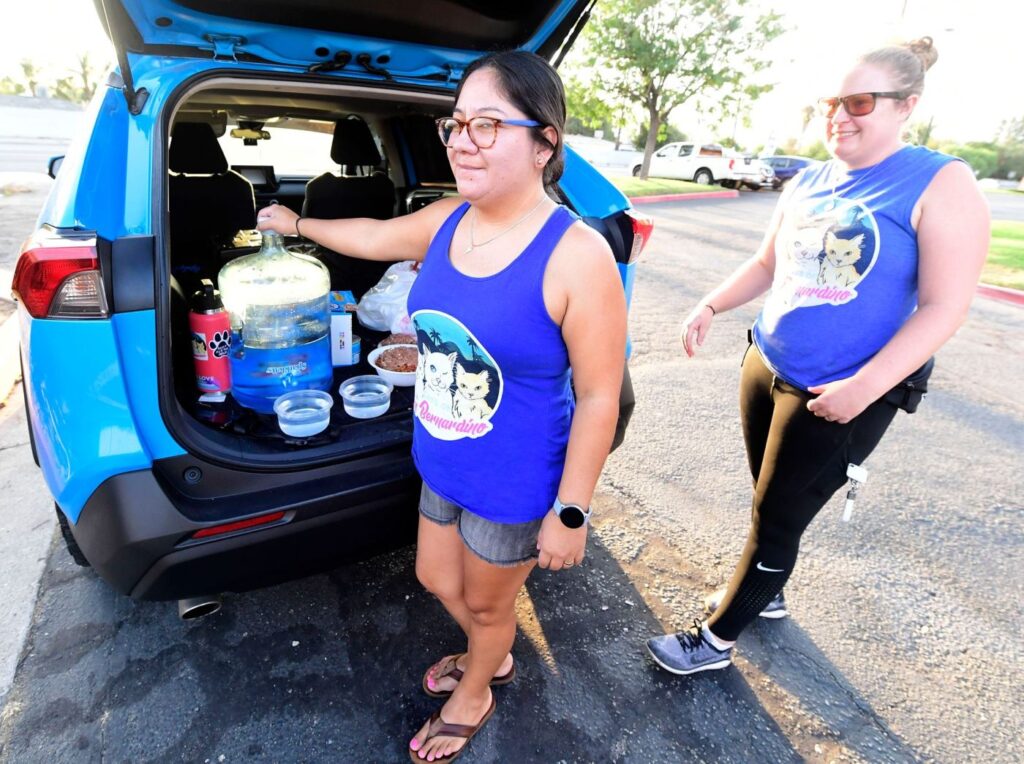
On a muggy Tuesday evening, Jaina and Ivy Spagis pulled into a shopping center on San Bernardino’s east side and parked near an enclosed dumpster behind the building.
They popped the back hatch of their electric-blue Rav4 with vanity plates reading “CATS SB” and began filling cardboard bowls with dry and wet cat food, pulling from a 22-pound bag of Meow Mix and assorted cans of Friskies. They poured water from a 5-gallon jug into a clear Tupperware bowl, then carefully placed the bowls on the ground behind the dumpster.
One by one, their charges quickly emerged from bushes, a ditch and the alleyway behind the shopping center — a colony of about 30 feral adult cats and kittens of various breeds. They cautiously made their way to the bowls of food and water and began eating heartily.
“They’re everywhere,” said Ivy Spagis, president of Cats of San Bernardino, a cat rescue she and wife Jaina, the organization’s vice president, started in 2017. They obtained nonprofit status in 2019.
The Spagises have carved a niche in feeding, spaying, neutering, microchipping and, in some cases, adopting out feral cats whose populations have proliferated across the city, state and nation since the onset of the coronavirus pandemic in 2020. The temporary suspension of spay and neuter surgeries, shelter closures and a national veterinarian shortage all have contributed to the problem, experts say.
Locally, the need for such services has never been greater. The Spagises estimate there are hundreds of thousands of feral cats citywide, and more than 1 million across the San Bernardino Valley.
When the couple started their home-based venture in 2017, they were monitoring seven colonies of feral cats in the 1-square-mile area of eastern San Bernardino. The number of feral colonies in the area has since doubled to 14, Ivy Spagis said.
Daily feedings, weekly fixings
The Spagises and their 10 volunteers work on a daily rotation feeding the cats.
Wearing their electric-blue Cats of San Bernardino tanktops, the Spagises traveled from one colony to another on Aug. 2, greeting the strays who hurriedly emerged from their nesting areas and urban hideaways to feed.
Every Thursday, they take seven of their trapped and/or rescued cats to Arrowview Animal Hospital on Highland Avenue. While the Spagises had 22 feral cats at their rescue on Aug. 2, the maximum number the vet can spay or neuter each week is seven.
Once the cats are “fixed,” they are returned to their respective colonies. A small, surgically removed chunk of their ears, called an “ear tip,” identifies them as having been spayed or neutered.
With only 10 volunteers, Cats of San Bernardino, as of now, only has the resources to care for the cats in the select area of San Bernardino it monitors daily.
“We just don’t have the manpower to take care of them all,” Jaina Spagis said. “We feed between 150 to 200 cats a day.”
Downtown sightings
Meanwhile, other feral cat colonies are not going unnoticed. In downtown San Bernardino, for example, a small colony of feral cats and kittens was spotted in bushes at the Department of Homeland Security Immigration and Customs Enforcement building at 655 W. Rialto Ave.
Evelyn Gonzalez, who works next door, said the colony has been nesting near the employee entrance gate for about a year. She started putting food out for them, but said she was told to stop by a man hired to take care of the problem.
“Their solution was to starve the cats,” Gonzalez said. “I told him you can call a rescue, you can drop them off. None of that.”
San Bernardino Animal Services Director Kris Watson said her officers picked up five newborn kittens at the ICE building in October 2021, but has had no further calls for service there since.
“We have reached out on a regular basis to San Bernardino Animal Services for their assistance in this matter, trying to get them to work with the cat population that’s there,” said Todd Willett, who oversees maintanance issues at the building that is leased by the federal government. “As far as starving the cats, we were advised by (Animal Services) not to feed the cats and to ask our tenants not to feed the cats, so that’s what we’ve done. Everything we are doing is based on Animal Services’ recommendations.”
Social media sensation
Cats of San Bernardino has created quite a buzz on social media, generating more than 2 million followers on TikTok, a quarter of a million on Instagram and about 40,000 on Facebook. It has adopted cats out to celebrities Kelly Osbourne and NASA pilot Carrie L. Worth, among others.
The nonprofit also is featured in an in-the-works documentary, but the Spagises asked that the network/studio producing the film not be named. The organization also is featured regularly on The Dodo, a social media brand focused on telling animal stories.
The Spagises rely solely on donations, and their supporters have been very generous, providing enough to allow them to purchase all the medical supplies they need, incuding incubators, vaccines, microchips, and IV fluids and to cover the $12,000 to $15,000 in monthly vet fees.
Trap, neuter, return
While some question what the Spagises are doing and advocate instead for the removal and euthanizing of feral cats to reduce their population, experts maintain that is futile, and that “trapping, neutering and returning,” or TNR, is the way to go.
The American Society for the Prevention of Cruelty to Animals, or ASPCA, estimates the number of feral cats, or community cats, in the U.S. to be in the tens of millions, and that feral cats ending up in animal shelters comprise a large percentage of those euthanized annually.
“Therefore, the organization supports (TNR) as a humane and effective way to manage the populations,” according to the organization’s website.
Vacuum effect
The reason removing feral cats from their respective colonies is futile, experts say, is because it creates a vacuum effect. In other words, if cats are removed from an area in which they are colonized, it leaves a territorial opening and more cats will move in to take their place.
“It’s definitely not an easy problem to fix,” Watson said. “If we had the ability to spay/neuter them and return them to the community, we would.”
Alley Cat Allies, a Maryland-based animal welfare nonprofit, maintains that the only way to stabilize cat populations is via the trap-neuter-return, or TNR, method.
“It is the humane, effective approach to community cats and is sound public policy,” according to the organization’s website.
The Humane Society of San Bernardino Valley does not have a shelter to pick up feral cats, nor does it monitor feral cat colonies in the city and across the valley, said HSSBV spokeswoman Jill Henderson.
HSSBV does, however, offer low-cost spay and neuter surgeries for cats, including feral cats, Monday through Friday.
“We have seen a significant increase in calls about stray cats or with community members confusing us with the shelter/animal control and looking for assistance with stray or feral cats,” Henderson said. “I can also say over the last year we have seen a large increase in community members bringing feral cats in for spay and neuter surgeries.”
For the Spagises, their goal is to expand and have a greater reach.
“We’re putting San Bernardino on the map for a good, positive reason,” Ivy Spagis said.
